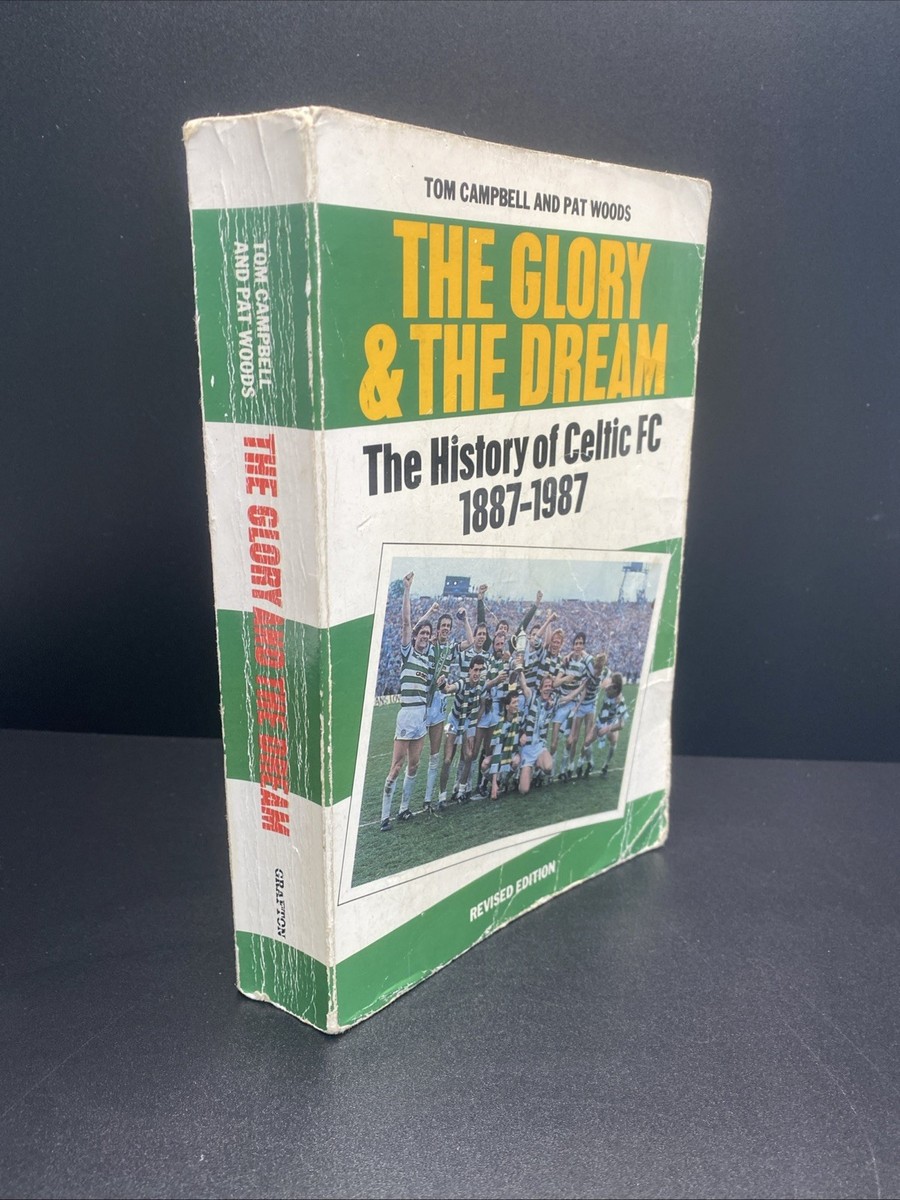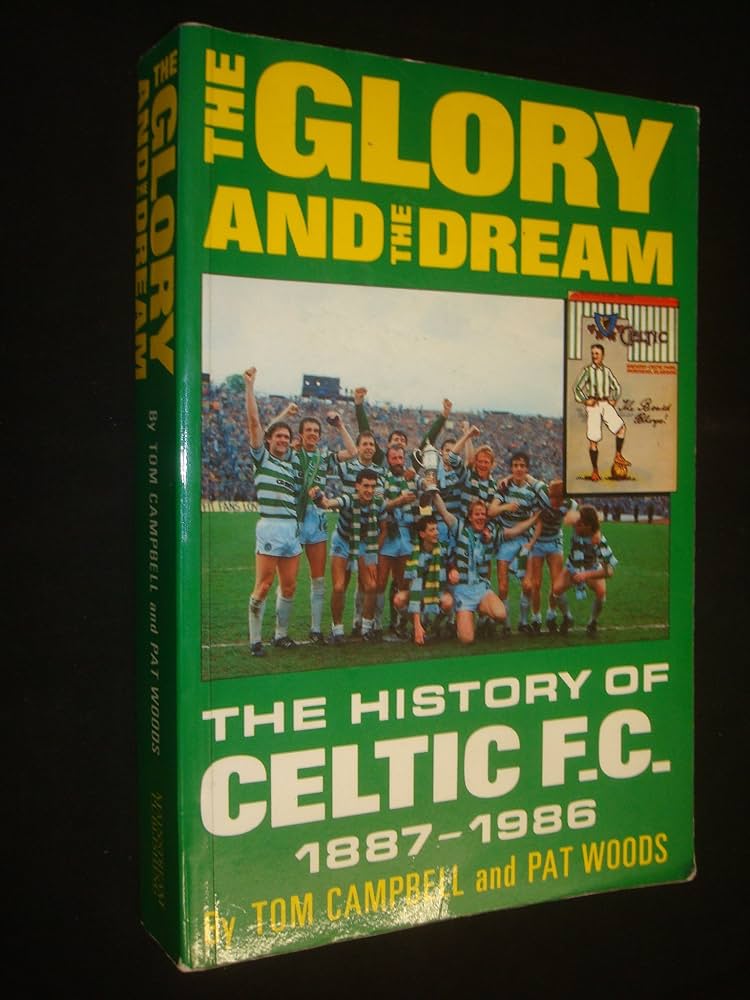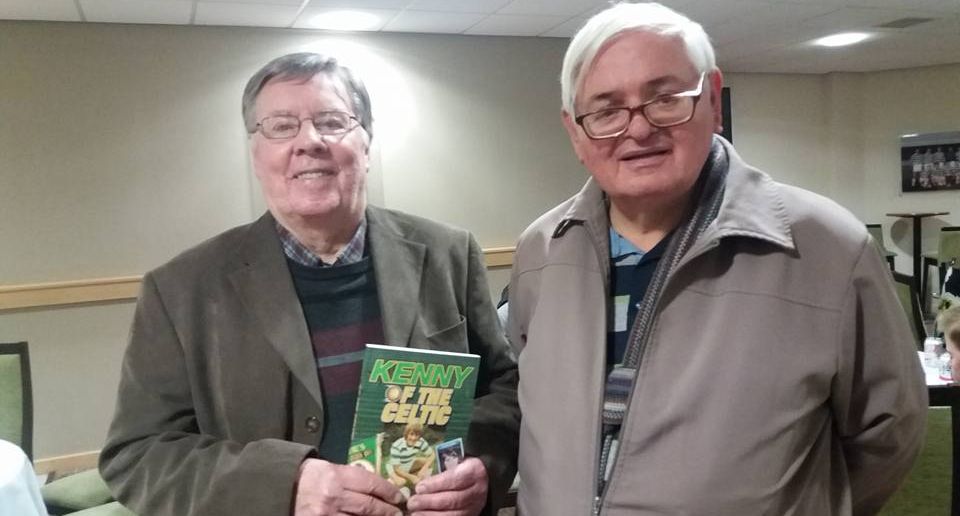Media | Celtic Books | If You Know The History
The Glory & the Dream
Author: Tom Campbell and Pat Woods
Paperback released: 1986 (Revised edition 1987)
ISBN: 0 586 20005 3
Synopsis
History of Glasgow Celtic Football Club, 1887-1986
Review
(by TheHumanTorpedo)
Commonly regarded as the definitive history of Celtic’s first 100 years ‘The Glory and the Dream’ is unquestionably a must have for anyone with a real passion for the Hoops.
At almost 500 pages long this fantastic book is the most complete and detailed account of the Celtic story you could hope to find. Illustrations and pictures are few but each page is crammed with words as the authors leave no stone unturned in their telling of the club’s birth and growth to a Scottish and football institution.
Taking the meeting at St Mary’s Church Hall in November 1887 as the birth of the club, Campbell and Woods then recall in detail every high and low of the Bhoys during the course of the next century.
The authors do not look at events through green tinted spectacles and are not afraid to highlight those moments when the actions of Celtic players, officials and supporters have betrayed the good name of the club. Unlike books dedicated to the history of a certain other Glasgow club The Glory and The Dream does not airbrush out the more controversial and sensitive aspects of football in Scotland. The book is all the better for such a directly honest approach.
The club’s many glorious achievements are of course covered in wonderfully vivid and evocative detail and there is no doubting that Celtic FC is a subject which the authors posses a great knowledge of and an even greater love for.
Along with the authors later work Dreams and Songs to Sing (see above) this masterpiece is as good a book on Celtic as you could possibly wish to own.
Details
- Paperback: 477 pages
- Publisher: Mainstream Publishing; 1st edition (Nov 1986)
- Language English
- ISBN-10: 1851580557
- ISBN-13: 978-1851580552
Other Reviews
(from Not The View)
Club histories are usually written by the faithful, for the faithful and with the intention of reinforcing the faith. This is hardly surprising in that they are usually commissioned by the club and entrusted to a journalist of known sympathies. It is only recently that ‘academic’ historians have entered this field, and here the main problem they face once the records have been opened to them (if there are any) is how to write an honest history without betraying the hospitality that has been bestowed on them?
For an ordinary fan to write a club history that is more than an extended brochure, without the back-up of the resources available to academic historians, or the inside information and finance available to journalists, requires a combination of faith and love such as is usually beyond even the most devoted fan. Such is the Celtic Football Club
of Glasgow, however, that it has found two such fans who have written a book which, if it is by fans and for fans, is a work of punctilious research which fearlessly paints in the warts wherever they are to be found: the result is an honest canvas of which any club should be proud. That the Celtic directors have banned sales of the book through their outlets is a reflection merely of the attitude of too many club directors who see in the slightest criticism a mortal slight, and who seem to be unaware that praise without blame is mere sycophancy.
That two fans should devote their spare time labours over several years to writing a massive history like this one is a tribute such as is offered to few clubs of any sport. But then the Celtic F.C. is no ordinary club.
The authors of The Glory and the Dream, a teacher of English in a Canadian high school and a librarian from Glasgow, have been fanatical Celtic supporters from their earliest days.
Tom Campbell left Scotland for Canada in the mid-1950s, but took with him his passion for the club he had been following since the Second World War, and maybe even before.
Pat Woods, although born in Wales, is as Glaswegian as they come, albeit of that Celtic strain that is pronounced with a hard ‘C’, unlike the club that has monopolised his faith.
Tom Campbell had previously chronicled the club’s rise from despondency in the 1940s and 1950s to the glory days of the late 1960s (in Glasgow Celtic, 1945-1970, published by himself in 1970) while Pat Woods is known to anyone who has worked on Scottish football at its most knowledgeable, and certainly it’s most generous and conscientious, researcher. The two have combined their talents as writer and researcher to produce a book that will stand for a long time as a model for a club history written for the fans. It also sets a challenge for the official centenary history of the club due to appear next year.
Unlike Campbell and Woods the club sees its foundation date as May 1888 when the first game was played. In doing so they refuse to recognise that it was on 6 November 1887 that a group of prominent Catholics met to announce the formation of a team to be called the Celtic Football and Athletic Club. This announcement was met by an immediate and willing response, of voluntary labour that went into the building of the club’s first ground, and of donations which by January 1888 had come in from various sections of the catholic community, led by the Archbishop of Glasgow and various other Church dignitaries and men of affairs. In local politics, small business and now in the country’s leading leisure pursuit, these Catholics were issuing a challenge to a Protestant establishment that saw ‘Irish’ Catholics as inferior in race, subversive in politics and enslaved to a foreign and idolatrous religion.
With such origins the Celtic F.C. was bound to have a stormy career, and so it was to prove. Ostensibly founded to feed the poor of Glasgow’s essentially catholic East End, it was also intended to keep them free from apostasy in their leisure time. Very soon the club emerged as a leader of the catholic community, scoring victories against the Protestants where it hurt most.
The Protestants were to get their revenge in the form of Glasgow Rangers, and thereafter both clubs benefited from that unholy partnership of business and bigotry that became known as The Old Firm, a story that has been told elsewhere.
In those early days there was no disguising the sympathies of the club. Its players and directors were happy to lend their names to demonstrations in favour of Irish Home Rule politics; the team played in the colours of the Emerald Isle and flew that country’s flag at the ground; and was supported by every priest, not just in Scotland, but in the United Kingdom, while it had the sympathies of the dispersed sons of Erin wherever they were to be found.
Today the club still flies the Irish flag and the team plays in Irish colours, but it has divorced itself from the Irish politics with which it was once so closely tied, although sympathy for the IRA can still be found today in the chants, slogans and banners of its hardcore support. That support is still mainly, but far from exclusively, catholic, and all its directors have been Catholics, but apart from that the club is open to anyone, as players in the team, employees in the office or at the ground, or as members of any branch of the club’s supporters’ organisations.
In short, the club has mirrored the growth of catholic community in Scottish society as well as playing a vital role in it, a role, which has diminished as that community, won its place in the mainstream of Scottish society and not just as an enclave (even ghetto) within it. With such material to work on the authors have the basis for a story where the truth is more exciting than fiction, and indeed the book gets off to a fascinating start with an imaginative reconstruction of the visit to the Maley family that was such a vital episode in the founding of the club: the trip out to Cathcart by Brother Walfrid, the priest whose idea the club was, and the indefatigable John Glass whose energies assured its success.
The purpose of the trip was to sign on Tom Maley, a player of no mean reputation, but it was to be the signing of Tom’s brother, Willie, that was the real catch, as he was to join the club as a player, then quickly become its secretary and manager, a post he held until he was sacked in 1940.
The Maley family themselves, as the authors point out, were a minor metaphor of the Irish tragedy, for the third man who led the expedition that night was Pat Welsh, then a successful master tailor but who would have been swinging from a rope in 1867 if it had not been for Sergeant Maley of the North British Fusiliers allowing his Irish patriotism to overcome his military duty when he released the young Fenian and let him escape to Scotland, from where he kept in touch. Sergeant Maley, in retirement in Scotland when this visit took place in December 1887, had four sons, each born in a different country.
Three of them were to make careers in football, ‘the fourth became a priest. This is a book about football, however, and the authors, while recounting the various Irish connections, are happy to insist on this, most notably in the title of the fifth chapter, which they arrive at with a certain relief: ‘Football…At Last’.
To my mind there is then too much on match descriptions, but the book was written for the fans; however, while the social background then becomes just that, it is never overlooked. The authors have combed just about every written source, re-living the travails of the club in leagues and cups and friendlies (and not so friendlies), and it is a tribute to the writers that even a non-fan like myself was happy to follow the ups and downs of the club through crises great and small, as well as the tragedies both real (such as the death of John Thomson) or imaginary (refereeing decisions that went the wrong way).
The approach is straight narrative followed by player sketches and an Extra Time section that adds chapters on the supporters, the stadium and the trophy room. The Extra Time section could better have been incorporated in the text, as the chapters are very short, and although the authors have tried to avoid it they have on occasions fallen into the trap of repetition.
There are also a couple of strange gaps, most notably the passing over of the Flag Flutter of the fifties. It is a pity; too, that such a thoroughly researched book does not have a bibliography. Although a chronological narrative, the authors avoid tedious description, criticising the club where justified and recognizing that other clubs exist for purposes other than to provide opposition.
The heftiest criticism in the book, indeed, falls on manager Maley and the directors: for their cheese-paring policies between the domination of Robert (later Sir) Kelly (chairman from 1947-70 and himself son of a star of the early days and chairman from 1909-14 whose policies and interference left Celtic as a minor power while the gentlemanly Jimmy McGrory bowed beneath him as manager (1945-65); and for the shabby treatment of manager Billy McNeil1 who was virtually sacked in 1983 by Desmond White (chairman from 1970 until his death in 1985, and himself son of Tom White, director from 1906-14 and chairman from 1914-47.
Such is the close paternalism of this ‘family club’!). This is not the sort of criticism sports directors are accustomed to in club histories, and it is believed to be the coverage of the McNeil1 episode that particularly riled the directors. If this is so then it reflects badly on them: all the criticism of Maley and the other directors is balanced by the real contributions they made to the club.
One of the great virtues of this history is that it is the first Celtic book that does not have some taint of the ghetto, some whine about the blind bias of anti-catholic bigots, and recognises that Catholics are not all free from the sins they prefer to see in others. This is the measure of the authors’ social maturity, which they share with the bulk of their fellow Catholics: their book, with its balance of praise and blame, is the highest compliment that has ever been paid to the Celtic Football Club. If the directors were to recognise this then they too might show a measure of maturity that would make them worthy of the position they hold in a football team that for well nigh on one hundred years has embodied the ‘glory and the dream’ of a community which, with all its faults and failings, has never lacked a certain gritty grandeur.



